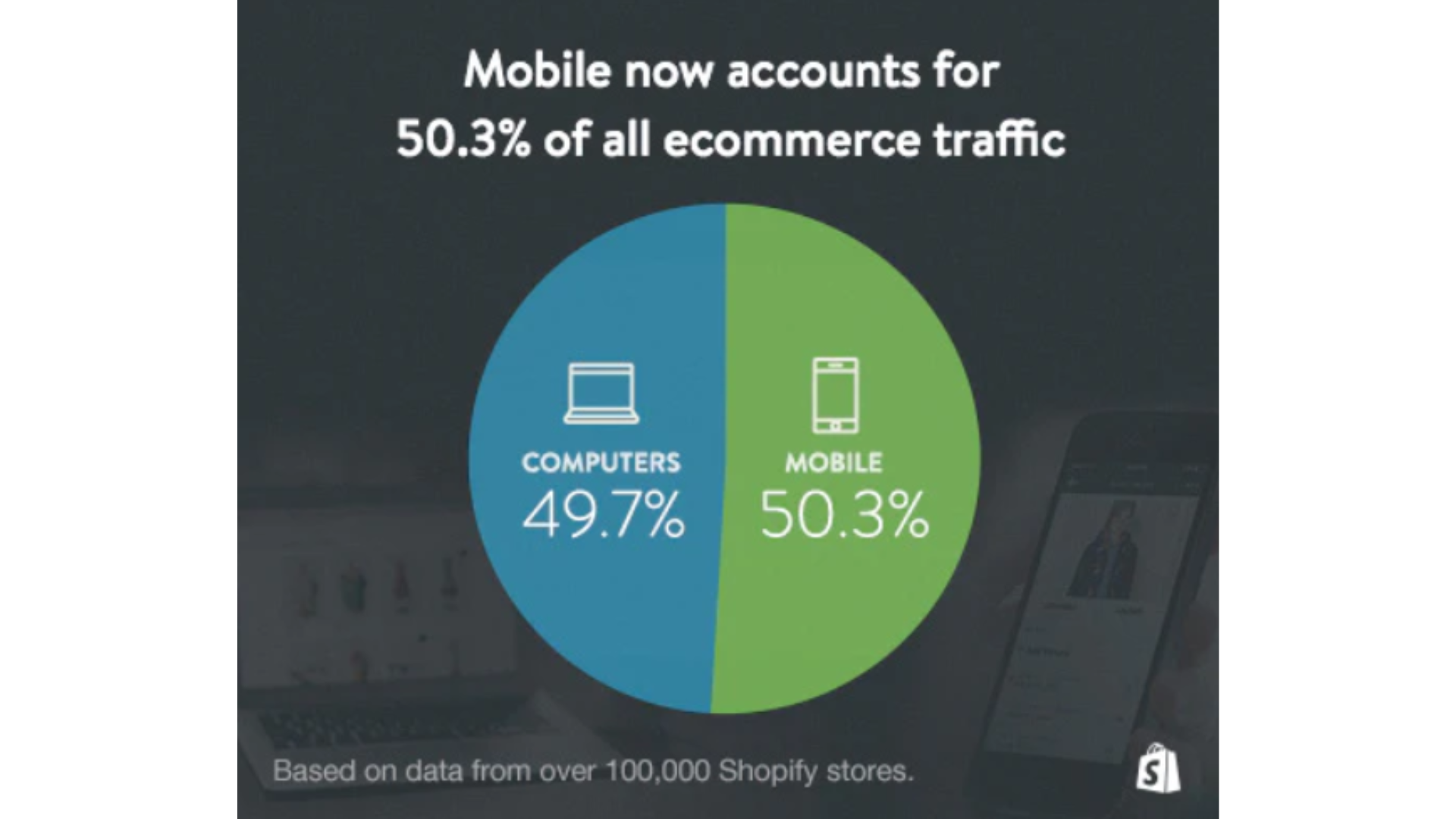- blog
- Statistics
- Shopify Customer Statistics: 50+ Key Stats for 2025

Table of Contents
Over 875 million customers shop from Shopify stores globally, making it one of the most powerful e-commerce ecosystems in the world. Whether you’re a Business Development Representative (BDR) looking to identify high-value prospects or an Account Executive (AE) targeting enterprise clients, understanding Shopify’s massive customer base is crucial for your success.
Shopify has evolved from a simple online store builder to a dominant force powering 30% of the US e-commerce market. With $8.88 billion in revenue for 2024 and a 25.77% year-over-year growth rate, the platform represents a goldmine of opportunities for B2B professionals.
In this comprehensive guide, we’ll dive deep into the latest Shopify customer statistics for 2025, covering everything from user demographics and revenue insights to global market trends. These data-driven insights will help you better understand your target market and craft more effective outreach strategies.
Shopify Business Statistics
Understanding Shopify’s scale and growth trajectory is essential for anyone targeting this ecosystem. The numbers tell a compelling story of consistent expansion and market dominance.
Store Count and User Base
As of 2025, there are 4.82 to 5.54 million live Shopify stores globally, depending on the methodology used for counting active versus inactive stores. This massive network serves as the foundation for the platform’s success.
The platform attracts 4.99 million daily active users and receives an average of 149.83 million monthly visits. During peak periods like November 2024, Shopify recorded 148 million visitors in a single month, demonstrating the platform’s ability to handle massive traffic volumes.
Financial Performance
Shopify’s financial health directly reflects the success of its merchant base. In 2024, the company generated $8.88 billion in total revenue, representing a robust 25.77% year-over-year growth. This growth is particularly impressive given the company’s already substantial scale.
The platform’s Gross Merchandise Volume (GMV) reached $292.28 billion in 2024, with quarterly GMV hitting $74.8 billion in Q1 2025 alone. This represents the total value of sales transacted by merchants on the platform, indicating the massive economic activity flowing through Shopify stores.
Market Position
Shopify commands 10.32% of the global e-commerce platform market share and an impressive 30% share of the US e-commerce platform market, making it the leading platform in America. Among the top 1 million e-commerce websites globally, Shopify powers 23-24% of these high-traffic sites.
“Need quality leads for your outreach? Salesso provides verified cold email addresses for Shopify merchants and helps warm up your email boxes for better deliverability. Start Free Trial“
Shopify’s E-commerce Impact Stats
The scale of customer interactions and purchasing behavior on Shopify provides valuable insights for understanding the platform’s true impact on global e-commerce.
Customer Reach and Engagement
Shopify merchants served over 875 million unique shoppers in 2024, marking a significant increase from 700 million in 2023. This represents a 25% year-over-year growth in customer reach, with 175 million new customers joining the platform in 2024 alone.
During major shopping events, the numbers become even more impressive. The 2023 Black Friday Cyber Monday weekend saw 61+ million consumers make purchases from Shopify-powered brands, generating $9.3 billion in sales – a 24% increase from the previous year.
Average Order Value and Conversion Metrics
The average order value (AOV) on Shopify ranges from $85 to $108, depending on the study and methodology used. During peak shopping periods like Black Friday Cyber Monday, the average cart value reaches $108.12, indicating higher spending during promotional events.
Conversion rates average 1.4% across all Shopify stores, though this varies significantly by industry and store optimization. The top 10% of Shopify stores achieve conversion rates of 2.7% on mobile devices and 3.8% on desktop, showing the potential for well-optimized stores.
Mobile Commerce Dominance
Mobile devices account for over 50.3% of traffic to Shopify stores, with this percentage reaching as high as 69% during major shopping events like Black Friday Cyber Monday. This mobile-first trend reflects broader consumer behavior shifts and highlights the importance of mobile optimization for merchant success.
Customer Retention and Loyalty
Shopify stores boast an average returning customer rate of 27%, according to RJMetrics research. However, this varies significantly across industries, with some stores achieving much higher retention rates through effective customer service and loyalty programs.
Over 50% of Shopify stores benefit from repeat purchases, demonstrating the platform’s ability to foster customer loyalty. The Shop Pay checkout system delivers 72% higher conversion rates compared to standard checkout processes, contributing to improved customer experience and retention.
Brands on Shopify Statistics
The diversity and success of brands using Shopify provide insight into the platform’s versatility and appeal across different market segments.
Enterprise Adoption with Shopify Plus
Shopify Plus, the enterprise-grade solution, powers 52,757 live stores as of 2025. These high-value merchants typically generate annual sales revenues ranging from $1 million to $500 million, making them prime targets for B2B solution providers.
The United States hosts 55% (approximately 29,144) of Shopify Plus stores, followed by the United Kingdom with 3,828 stores and Australia with 3,056 stores. Plus merchants experience an impressive average year-over-year growth rate of 126%, significantly outpacing industry standards.
Store Categories and Verticals
Apparel remains king with over 500,000 stores dedicated to fashion and clothing items, making it the largest category on the platform. This is followed by:
- Home & Garden: 229,000+ stores
- Beauty & Fitness: 198,000+ stores
- Food & Drink: 116,000-124,000 stores
- Electronics: Significant presence with high revenue potential
Notable Brands and Success Stories
Major brands across various industries trust Shopify for their e-commerce operations, including Gymshark, Kylie Cosmetics, Tesla, Allbirds, SKIMS, Supreme, Heinz, and Red Bull. These success stories demonstrate Shopify’s capability to handle enterprise-level requirements and high transaction volumes.
Revenue Distribution
The average Shopify store generates approximately $5,583 per month, though this varies significantly across different store sizes and industries. Top-performing stores (top 10%) can earn $10,866 monthly or more, with some high-volume operations generating hundreds of thousands in monthly revenue.
Typical profit margins for e-commerce businesses on Shopify hover between 10% and 20%, providing merchants with healthy returns on their investments in the platform and related services.
Scale Your Outreach
Target High-Value Shopify Merchants
Find verified emails, warm up your inbox, and send effective cold email campaigns
Get Started
Global Shopify Statistics
Shopify’s international presence creates opportunities for B2B providers targeting merchants across different geographic markets.
Geographic Distribution
The United States dominates with 2.67 to 3.14 million Shopify stores, representing approximately 57.7% of all stores worldwide. This concentration makes the US market particularly attractive for B2B solution providers.
Other significant markets include:
- United Kingdom: 191,503-223,000 stores
- Australia: 150,000+ stores
- Canada: 108,000+ stores
- Germany: 118,000+ stores
- Brazil: 135,000+ stores
International Growth Trends
Shopify’s international revenue grew by 33% in recent periods, indicating strong expansion beyond North American markets. Cross-border transactions represent 15% of all orders, highlighting the global nature of commerce on the platform.
The platform supports businesses in over 175 countries and provides language support for up to 20 languages on most plans, facilitating international expansion for merchants.
Regional Market Insights
North America accounts for 71.35% of Shopify’s total revenue ($5.04 billion in 2023), while all other international markets combined generate $2.02 billion. This distribution shows both the current dominance of North American markets and the significant growth potential in international regions.
UK Shopify Statistics
The United Kingdom represents one of Shopify’s most important international markets, offering specific insights for businesses targeting this region.
Market Size and Growth
The UK hosts 191,503 to 223,000 Shopify stores, making it the second-largest market after the United States. The UK market has experienced 37% year-over-year growth, demonstrating strong adoption and expansion trends.
Market Share and Competition
In the UK, Shopify holds a 23% market share, positioning it as the second-largest e-commerce platform behind Wix Stores at 24%. This close competition indicates a dynamic market with opportunities for continued growth.
Enterprise Presence
The UK hosts 3,200+ Shopify Plus stores, representing a significant concentration of enterprise-level merchants. These businesses typically have more complex needs and larger budgets for B2B solutions.
Regional Distribution
The majority of UK Shopify stores are located in England (163,461 stores), with smaller concentrations in Scotland, Wales, and Northern Ireland. This geographic concentration can help B2B providers focus their targeting efforts.
“Reach UK Shopify merchants effectively with Salesso’s targeted email lists and advanced segmentation features. Try Now“
Shopify App & Theme Statistics
The Shopify App Store ecosystem provides crucial insights into merchant needs, pain points, and spending patterns on additional tools and services.
App Store Scale and Adoption
The Shopify App Store features over 13,000 applications, supported by more than 7,000 vendors and partner developers. This vibrant ecosystem indicates strong demand for third-party solutions among merchants.
An impressive 85-87% of Shopify merchants use apps to enhance their store functionality, with the average merchant installing approximately 6 apps. This high adoption rate creates substantial opportunities for app developers and B2B service providers.
Popular App Categories
Based on review counts and adoption rates, the most popular app categories include:
- Judge.me Product Reviews: Installed by 16.1% of stores
- Shopify Inbox: Used by 15.0% of stores
- Klaviyo Email Marketing & SMS: Adopted by 14.1% of stores
- Analytics and SEO tools: High demand for data backup and market insights
- Shipping and logistics solutions: Critical for customer service optimization
- Upsell and cross-sell applications: Focus on increasing average order values
Developer Economics
The App Store represents a significant economic opportunity, with Shopify paying out $1.0 billion in the last 12 months to partners, primarily for apps benefiting merchants. Top-performing developers can earn $167,000 annually, while the average developer revenue is around $93,000 per year.
Theme Usage Patterns
Dawn theme is used by 8.5% of stores and ranks as the second most popular theme, while Debut theme is used by 5.6% of stores. The trademark theme leads with 23.4% adoption, indicating preferences for clean, professional designs.
App Pricing and Merchant Spending
The average cost of a Shopify app plan is approximately $66.54 per month, though 45.71% of apps offer free plans or trials. Merchants typically spend around $120 monthly on apps total, indicating willingness to invest in tools that provide clear value.
Conclusion
The Shopify ecosystem represents one of the most dynamic and rapidly growing segments in e-commerce, with 875+ million customers driving $292.28 billion in annual GMV across 4.82+ million active stores. For BDRs and AEs, these numbers translate into massive opportunities.
Key takeaways for B2B professionals include:
Market Size: With millions of active merchants and consistent growth rates above 25%, Shopify provides an enormous addressable market for B2B solutions.
High-Value Segments: The 52,757 Shopify Plus stores represent enterprise-level prospects with substantial budgets and complex needs, while the 500,000+ apparel stores offer category-specific targeting opportunities.
Global Reach: 175+ countries and strong international growth create opportunities for solutions addressing cross-border commerce, localization, and international expansion.
Technology Adoption: 85-87% of merchants use apps and spend an average of $120 monthly on third-party tools, indicating openness to new solutions that provide clear value.
The platform’s continued innovation in areas like AI integration, B2B commerce (with 140%+ GMV growth), and international expansion ensures that new opportunities will continue emerging for forward-thinking B2B providers.
Ready to Connect?
Find Shopify Store Owners Fast
Access verified contact data, automate your outreach, and close more deals with Salesso’s comprehensive cold email platform
Start Here
Frequently Asked Questions
How many customers does Shopify have?
What is the average order value on Shopify stores?
How many Shopify stores are there globally?
What percentage of Shopify stores are successful?
What are the most popular Shopify store categories?
How much do Shopify merchants make on average?

Find Quality Leads in Just One Click
Install SalesSo’s Chrome Extension and start collecting leads while you browse your favorite sites
